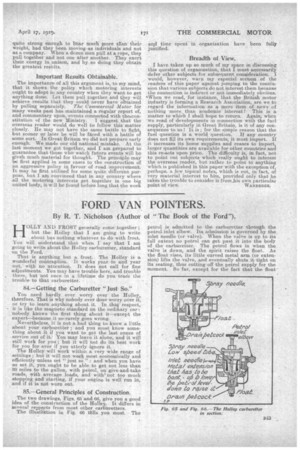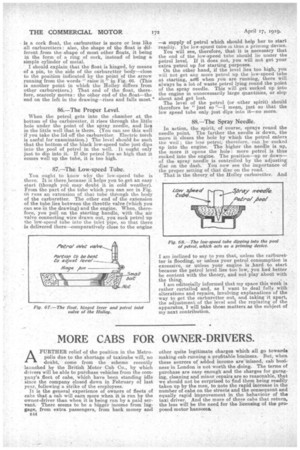FORD VAN POINTERS.
Page 17

Page 18

If you've noticed an error in this article please click here to report it so we can fix it.
By R. T. Nicholson (Author of "The Book of the Ford").
HOLLY AND FROST generally come together ; . but the Holley that I am going to write about has nothing whatever to do with frost. You will understand that when I say that I am going to write about the Holley carburetter, standard on the Ford.
That is anything but a frost. The Holley is a wonderful contraption. It works year in and year out, with no -attention. It does not call for fine adjustments. You may have trouble here, and trouble there, but not once in a lifetime do you trace the trouble to that carburetter.
84.—Getting the Carburetter "Just So."
You need hardly ever worry over the Holley, therefore. That is why nobody ever does worry over it, or try to learn anything about it. In that' respect, it is like the magneto standard on the ordinary car : nobody knows the first thing about it—except the expert—because it so-rarely goes wrong.
Nevertheless, it is not a bad thing to know a little about your carburetter ; and you must know something about it if you want to get the last ounce of
• service out of it: You may leave it alone, and it will still work for you ; but it will not do its best work for you for ever -if you utterly ignore it. The Holley will work within a very wide range of settings ; but it will not work most economically and efficiently unless set "just so " : and when you have so set it, you ought to be able to get not less than 30 miles to the gallon, with petrol, on give-and-take roads, with average loads, and with' not too much stopping and starting, if your engine is well run in, . and if -it is not worn out.
85.—General Principles of Construction.
The two drawings, Figs. 65 and 66, give you a good idea of the construction of the HolleN. It differs in several re,speets from most other carburetters. The illusfttion in Fig. 66 -ails you most. The
petrol is admitted to the carburetter through the petrol inlet elbow. Its admission is governed by the inlet needle (or valve). When the valve is up to its full extent no petrol can get past it into the body of the carburetter. The petrol flows in when the valve is down, and the spirit raises the float. As the float rises, its little curved metal arm (or extension) lifts the valve, and eventually shuts it tight on its seating, thus cutting off the petrol supply for the moment, So far, except for the fact that the float is a cork float, the carburetter is more or less like all carburetters : also, the shape of the float is different from the shape of most other floats, it being in the form of a ring of cork, instead of being a simple cylinder of metal.
I should explain that the float is hinged, by means of a pin, to the side of the carburetter body—close to the position indicated by the point of the arrow running from the words "raise it" in Fig. 66. (This is another point in which the Holley differs from other carburetters.) That end of the float, there-. fore, scarcely moves : the other end of the .float—the end on the left in the drawing—rises and falls most.'
86.—The Proper Level.
When the petrol gets into the chamber at the bottom of the carburetter, it rises through the little hole under the point of the spray needle, and lies in the little well that is there. (You can see this well if you take the lid off the carburetter. Electric torch is useful for examination.) The level should be such that the bottom of the black low-speed tube just dips into the pool of petrol in the well. .It ought only just to dip into it. If the petrol lies so high that it comes well up the tube, it is too high.
87.—The Low-speed Tube.
You ought to know why the Tow-speed tube is there. It is there because it Lelps you to get an easy start (though yoil maydoubt it in cold weather). From the part of the tube which you can see in Fig. 08 runs an extension of that tube through the body of the carburetter. The other end of the extension of the tube lies between the throttle valve (which you can see in the drawing) and the engine. When, therefore, you pull on the starting handle, with the air valve connecting wire drawn out, you suck petrol up the low-speed tube into the inlet pipe, so that there is delivered there—comparatively close to the engine —a supply of petrol which should help her to start readily. The low-speed tube is thus a priming device. You will see, therefore, that it is necessary that the end of the low-speed tube should lie under the petrol level. If it does not, you will not get your extra petrol up for starting purposes.
On the other hand, it the level lies too high, you will not get a,ny more petrol up the low-speed tube at starting, ant when you are running, there will always be a lot of waste petrol lying round the point of the spray needle. This will get sucked up into the engine in unnecessarily large quantities, or slop about and get lost.
The level of the petrol (or other spirit) should therefore be " just so "—I mean, just so that the low speed tube only just dips into it—no more.
88.—The Spray Needle.
In action the spirit, of course, sprays round the needle point, The farther the needle is down, the more it closes the hole by which the petrol enters the well ; the less petrol, therefore, can be sucked up into the engine. The higher the needle is up, the more it opensthe hole : more petrol is thus sucked into the engine. The position—up or down— of the' spray needle is controlled by the adjusting disc on the dash.' You now see the importance of the proper setting of that disc on the road.
That is the theory Of the Holley carburetter. And
I am inclined to say to you that, unless the carburetter is flooding, or unless your petrol consumption is excessive, or unless your engine is jiard to start because the petrol level lies too low, you had better be content with the theory, and not play about with the thing.
I am editorially informed that my space this week is rather curtailed and, as I want to deal fully with alterations and repairs, involving explanations of the way to get the carburetter out, and taking it apart, the adjustment of the level and the replacing of the apparatus, I will take those matters as the subject of my next contribution.






















